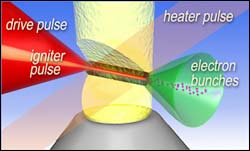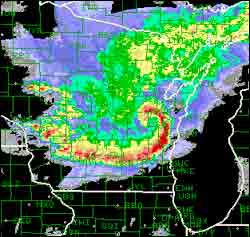For the very first time, the genetic make-up of a planktonic marine alga has been sequenced. During this process, a team of international scientists found unexpected metabolic pathways in the diatom Thalassiosira pseudonana. The results will be published in the scientific journal ‘Science’ this week.
The fact that Thalassiosira pseudonana operates a urea cycle, has been a special discovery. Up to now, this metabolic pathway for ammonia detoxification was known only from the liver c
Scientists from the UK and the USA have successfully demonstrated a new technique that could help to shrink the size and cost of future particle accelerators for fundamental physics experiments and applications in materials and biomedicine.
Using the huge electric fields in laser-produced plasmas, they have accelerated beams of electrons close to the speed of light, in an important step towards the development of a working laser electron accelerator that could sit on a table top.

Researchers at the Department of Energy’s Lawrence Berkeley National Laboratory have taken a giant step toward realizing the promise of laser wakefield acceleration, by guiding and controlling extremely intense laser beams over greater distances than ever before to produce high-quality, energetic electron beams.
For a quarter of a century physicists have been trying to push charged particles to high energies with devices called laser wakefield accelerators. In theory, particles ac

A set of newly documented small-scale circulations embedded in thunderstorm squall lines not only spew destructive straight-line winds, but may spawn up to 20% of all U.S. tornadoes. And the remnant circulations from large thunderstorm clusters can survive for days, triggering new storm cells. Over warm oceans, similar remnant circulations provide seed for hurricane development. Scientists expect these and other findings to help improve forecasts of damaging winds and heavy rain.
T

A team of 27 U.S. marine scientists beginning an intensive program of exploration at the Lau Basin in the South Pacific has discovered a new cluster of hydrothermal vents along a volcanically active crack in the seafloor. About a mile and a half down, the basin could hold answers to questions about the origin of life on Earth, say the scientists, whose plans for their “South Pacific Odyssey” include an unprecedented number of research expeditions to this geologically unique “back-arc basin” duri
Marine microbes shape the chemical composition of the Earth’s oceans and atmosphere, yet we know essentially nothing about them. Now, thanks to major grants from the Gordon and Betty Moore Foundation, MIT researchers aim to learn dramatically more about some of the most important organisms on the globe.
Professors Penny Chisholm and Ed DeLong are among the four Moore Foundation Investigators in Marine Science selected nationally. Each inaugural investigator will receive almost $5